The Quantity and Composition of Leachate from Hop Plant Biomass during Composting Process
Abstract
:1. Introduction
2. Materials and Methods
2.1. Experiment Setup
2.2. Leachate and Hop Biomass Sampling
2.3. Chemical Analyses
2.4. Weather Conditions during the Experiment
2.5. Data Processing
3. Results and Discussion
3.1. Temperature
3.2. The Impact of Composting Procedure on the Leachate Quantity and Composition during Composting
3.3. The Impact of Composting Procedure on Biomass Properties Related to Time Stamp
3.4. Composting Pile LES—Correlation between the Precipitation Amount and Leachate Amount and Its Parameters
4. Conclusions
Author Contributions
Funding
Institutional Review Board Statement
Informed Consent Statement
Data Availability Statement
Acknowledgments
Conflicts of Interest
References
- Čeh, B.; Čremožnik, B.; Oset Luskar, M. Nutrients uptake with hop (Humulus lupulus L.) as the basis for fertilization rate determination and hop biomass after harvest. Proceedings of New Challenges in Agronomy 2019—Ljubljana, Laško, Slovenia, 31 January–1 February 2019; pp. 63–69. [Google Scholar]
- Abram, V.; Čeh, B.; Vidmar, M.; Hercezi, M.; Lazić, N.; Bucik, V.; Smole Možina, S.; Košir, I.J.; Kač, M.; Demšar, L.; et al. A comparison of antioxidant and antimicrobial activity between hop leaves and hop cones. Ind. Crops Prod. 2015, 64, 124–134. [Google Scholar] [CrossRef]
- Čeh, B.; Luskar, L.; Čremožnik, B. Hop biomass after harvest as input material for composting. Hop Bull. 2019, 26, 81–90. [Google Scholar]
- Maniadakis, K.; Lasaridi, K.; Manios, Y.; Kyriacou, M.; Manios, T. Integrated waste management through producers and consumers education: Composting of vegetable crop residues for reuse in cultivation. J. Environ. Sci. Health Part B 2004, 39, 169–183. [Google Scholar] [CrossRef]
- Amlinger, F.; Peyr, S.; Müsken, J. State of the Art of Composting; Austrian Ministry for Agriculture and Forestry, Environment and Water Management: Wein, Austria, 2009.
- Confesor, R., Jr.; Hamlett, J.; Shannon, R.; Graves, R. Potential pollutants from farm, food and yard waste composts at differing ages: Leaching potential of nutrients under column experiments. Part II. Compost Sci. Util. 2009, 17, 6–17. [Google Scholar] [CrossRef]
- McCarthy, J.; Zachara, J. Subsurface transport of contaminants. Environ. Sci. Technol. 1989, 23, 496–502. [Google Scholar] [CrossRef] [Green Version]
- Krogmann, U.; Woyczechowski, H. Selected characteristics of leachate, condensate and runoff released during composting of biogenic waste. Waste Manag. Res. 2000, 18, 235–248. [Google Scholar] [CrossRef]
- Azim, K.; Soudi, B.; Boukhari, S.; Perissol, C.; Roussos, S.; Thami Alami, I. Composting parameters and compost quality: A literature review. Organ. Agric. 2017, 8, 141–158. [Google Scholar] [CrossRef]
- Brewer, L.; Andrews, N.; Sullivan, D.; Gehr, W. Agricultural Composting and Water Quality; Oregon State University: Corvallis, OR, USA, 2013; pp. 1–29. [Google Scholar]
- Hamid, H.; Qi, L.; Harun, H.; Sunar, N.; Ahmad, F.; Muhamad, M.; Hamidon, N. Development of organic fertilizer from food waste by composting in UTHM campus Pagoh. J. Des. Sustain. Environ. 2019, 1, 1–6. [Google Scholar]
- Ghanney, P.; Qiu, H.; Anning, D.K.; Yang, H.; Wang, Y.; Kugbe, J.X. Moisture-induced pattern of gases and physicochemical indices in corn straw and cow manure composting. Appl. Sci. 2021, 11, 8493. [Google Scholar] [CrossRef]
- De Corato, U.; De Bari, I.; Viola, E.; Pugliese, M. Assessing the main opportunities of integrated biorefining from agro-bioenergy co/by-products and agroindustrial residues into high-value added products associated to some emerging markets: A review. Renew. Sustain. Energy Rev. 2018, 88, 326–346. [Google Scholar] [CrossRef]
- Guo, M. Application of biochar for soil physical improvement. Agric. Environ. Appl. Biochar Adv. Barriers 2016, 63, 101–122. [Google Scholar]
- Enaime, G.; Lübken, M. Agricultural waste-based biochar for agronomic applications. Appl. Sci. 2021, 11, 8914. [Google Scholar] [CrossRef]
- Hodnik, A. Kemične analize talnih vzorcev, rastlinskih vzorcev in odcednih vod [Chemical Analysis of Soil Samples, Plant Samples and Drainage Water]; Biotehniška fakulteta, Katedra za pedologijo, prehrano rastlin in ekologijo: Ljubljana, Slovenia, 1988; 92p. [Google Scholar]
- Jackson, M.L. Soil Chemical Analysis; Prentice Hall, Inc.: Englewood Cliffs, NJ, USA, 1958; 498p. [Google Scholar]
- AGROMET—Agrometeorološki Portal Slovenije/Agrometeorological Portal of Slovenia. June. 2021. Available online: http://agromet.mkgp.gov.si/APP/Tag/Export/164 (accessed on 12 December 2021).
- Van der Wurff AW, G.; Fuchs, J.G.; Raviv, M.; Termorshuizen, A. Handbook for Composting and Compost use in Organic Horticulture; BioGreenhouse: Wageningen, The Netherlands, 2016. [Google Scholar]
- Wang, Y.; Akdeniz, N.; Yi, S. Biochar-amended poultry mortality composting to increase compost temperatures, reduce ammonia emissions, and decrease leachate’s chemical oxygen demand. Agric. Ecosyst. Environ. 2021, 315, 107451. [Google Scholar] [CrossRef]
- Beaudette, V. Caractérisation des Liquides Issus du Compostage de Résidus Agroalimentaires Végétaux. Master’s Thesis, Université Laval, Québec, QC, Canada, 2014. Available online: http://hdl.handle.net/20.500.11794/25340 (accessed on 16 December 2021).
- Ghiasinejad, H.; Ghasemi, M.; Pazoki, M.; Shariatmadari, N. Prediction of landfill leachate quantity in arid and semiarid climate: A case study of Aradkouh, Tehran. Int. J. Environ. Sci. Technol. 2021, 18, 589–600. [Google Scholar] [CrossRef]
- Antonangelo, J.; Xiao, S.; Hailin, Z. The roles of co-composted biochar (COMBI) in improving soil quality, crop productivity, and toxic metal amelioration. J. Environ. Manag. 2021, 277, 111443. [Google Scholar] [CrossRef]
- Halim, A.; Lee, K.; Idris, M. Biogas production from goat and chicken manure in Malaysia. Appl. Ecol. Environ. Res. 2017, 15, 529–535. [Google Scholar]
- Mtolera, I.; Dongli, S. Effect of effective microorganism and gypsum amendments on nutrient leaching, pH, electrical conductivity, and Okra growth parameters under coastal saline soil. Commun. Soil Sci. Plant Anal. 2018, 49, 1–11. [Google Scholar] [CrossRef]
- Centers for Disease Control and Prevention. Available online: https://www.cdc.gov/healthywater/drinking/private/wells/disease/nitrate.html (accessed on 27 December 2021).
- Sall, P.M.; Antoun, H.; Chalifour, F.P.; Beauchamp, C.J. Potential use of leachate from composted fruit and vegetable waste as fertilizer for corn. Cogent Food Agric. 2019, 5, 1580180. [Google Scholar] [CrossRef]
- Inckel, M.; de Smet, P.; Tersmett, T.; Veldkamp, T. The Preparation and Use of Compost; Agromisa: Wageningen, The Netherlands, 2005; Volume 27. [Google Scholar]
- Clark, G. Technologies for Compost Production from Plant Byproducts; Byproducts from Agriculture and Fisheries; Wiley: Hoboken, NJ, USA, 2019; pp. 545–562. [Google Scholar]
- Confesor, R., Jr.; Hamlett, J.; Shannon, R.; Graves, R. Movement of nitrogen and phosphorus downslope and beneath a manure and organic waste composting site. Compost Sci. Util. 2007, 15, 119–126. [Google Scholar] [CrossRef]
- Footer, A. Bokashi Composting: Scraps to Soil in Weeks; New Society Publishers: Gabriola, BC, Canada, 2014. [Google Scholar]
- Iqbal, H.; Garcia-Perez, M.; Flury, M. Effect of biochar on leaching of organic carbon, nitrogen, and phosphorus from compost in bioretention systems. Sci. Total Environ. 2015, 521, 37–45. [Google Scholar] [CrossRef]
- Cáceres, R.; Magrí, A.; Marfà, O. Nitrification of leachates from manure composting under field conditions and their use in horticulture. Waste Manag. 2015, 44, 72–81. [Google Scholar] [CrossRef]
- Wu, D.; Liu, P.; Luo, Y.; Tian, G.; Mahmood, Q. Nitrogen transformations during co-composting of herbal residues, spent mushrooms, and sludge. J. Zhejiang Univ. Sci. B Biomed. Biotechnol. 2010, 11, 497–505. [Google Scholar] [CrossRef] [PubMed] [Green Version]
- Amatya, M.; Kansakar, R.; Tare, V.; Fiksdal, L. Role of pH on biological Nitrification Process. J. Inst. Eng. 2011, 8, 119–125. [Google Scholar] [CrossRef] [Green Version]
- Park, S.; Bae, W.; Chung, J.; Baek, S.C. Empirical model of the pH dependence of the maximum specific nitrification rate. Process Biochem. 2007, 42, 1671–1676. [Google Scholar] [CrossRef]
- Larney, F.J.; Olson, A.F.; Miller, J.J.; Tovell, B.C. Nitrogen and phosphorus in runoff from cattle manure compost windrows of different maturities. J. Environ. Qual. 2014, 43, 671–680. [Google Scholar] [CrossRef] [PubMed]
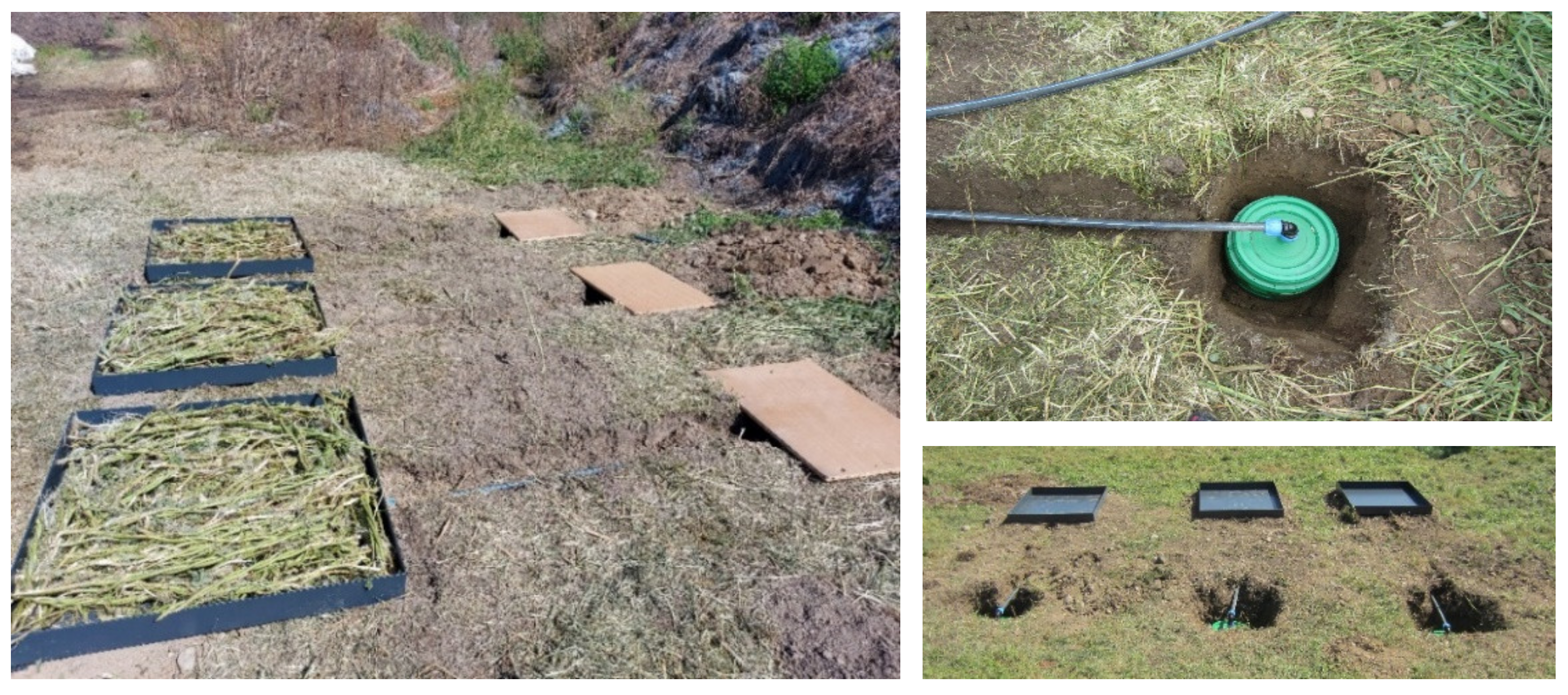
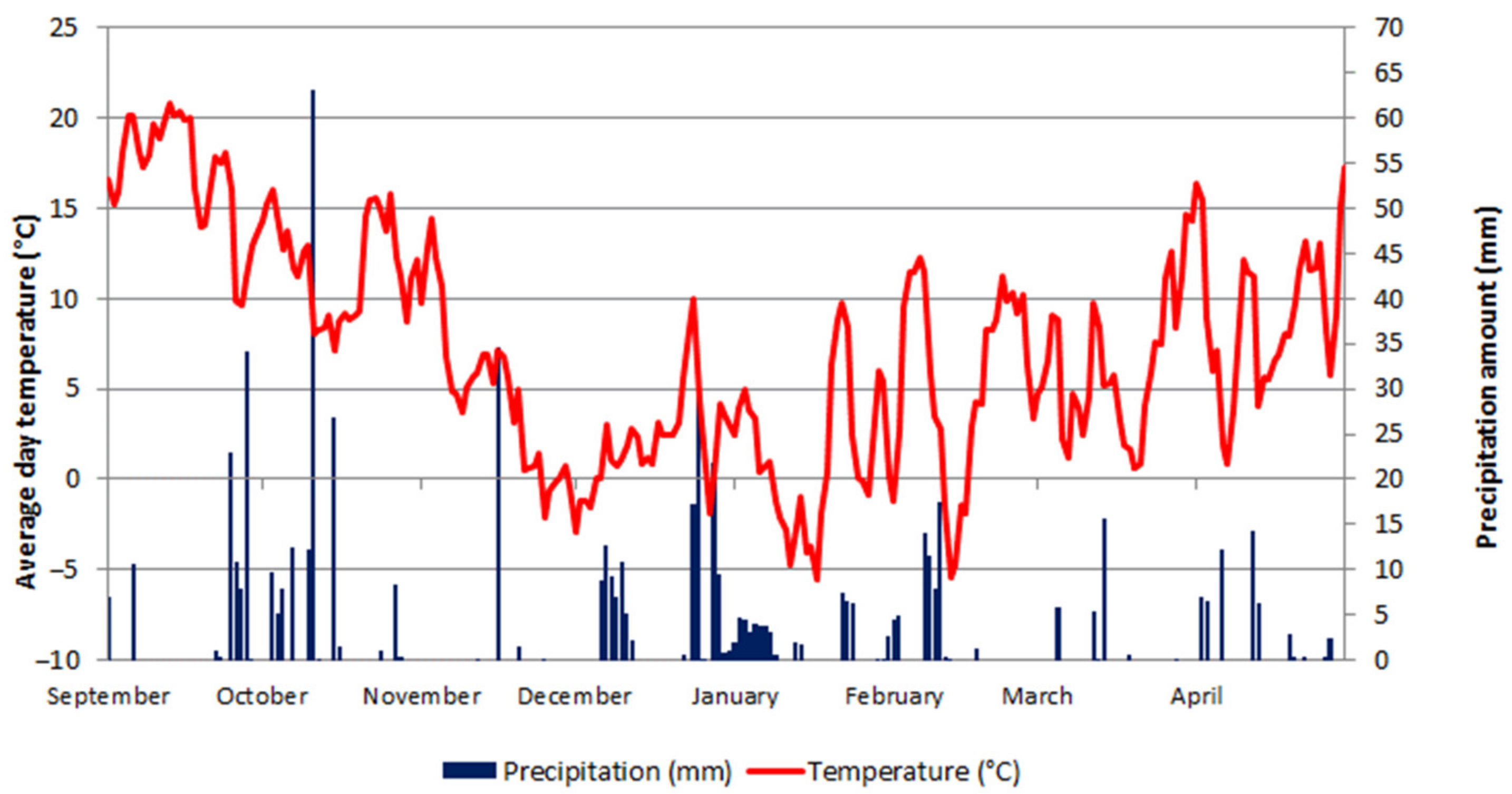

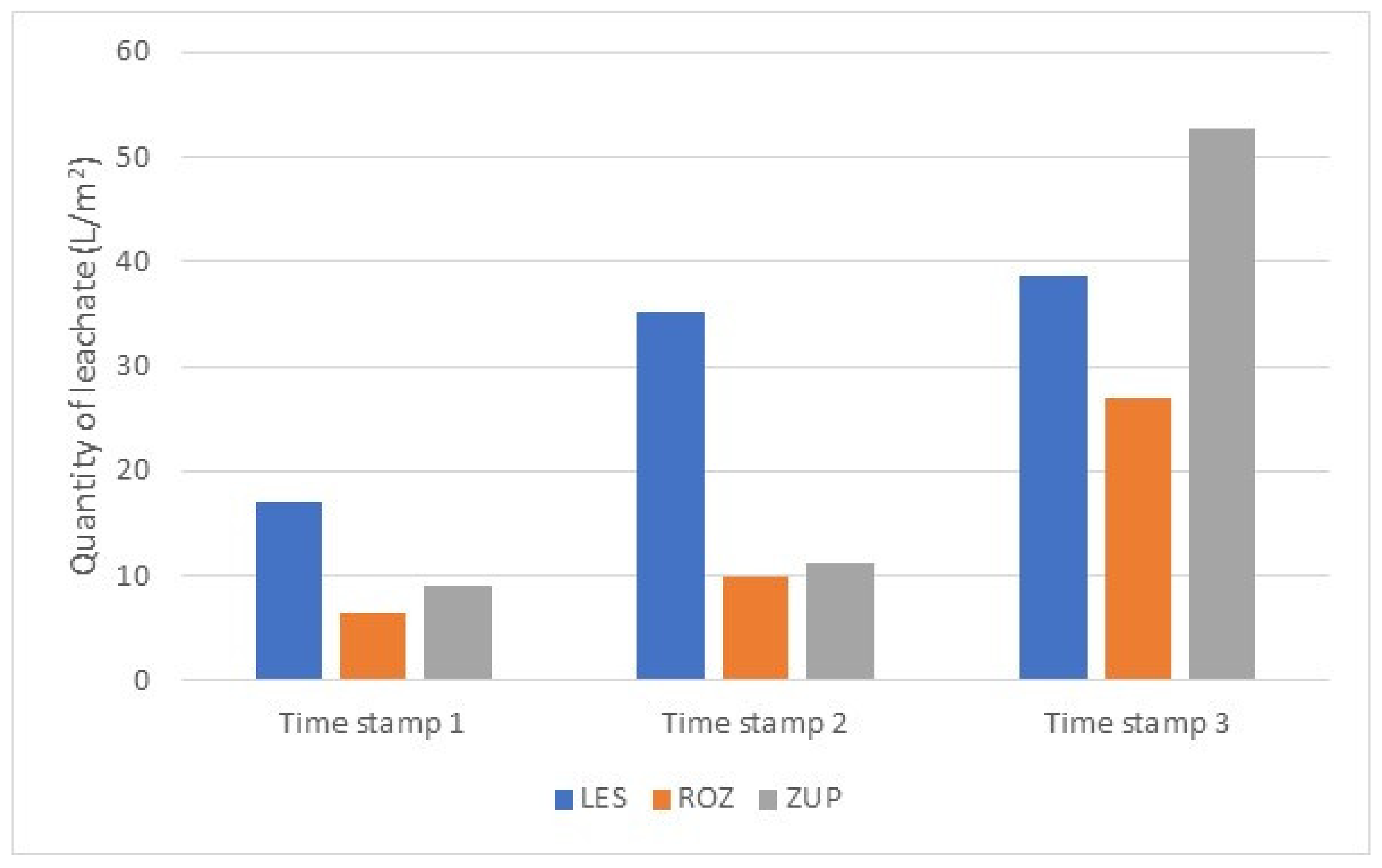
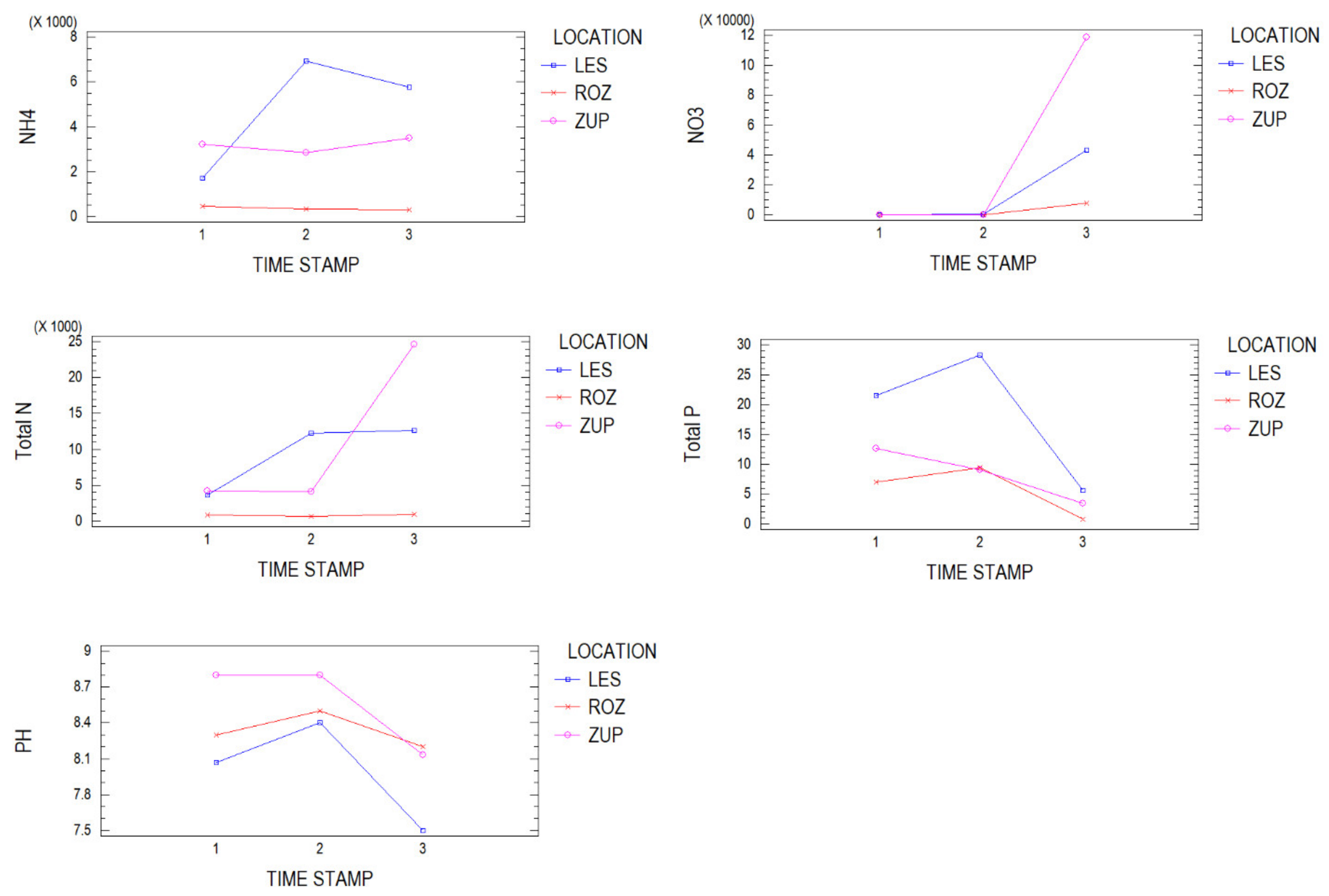
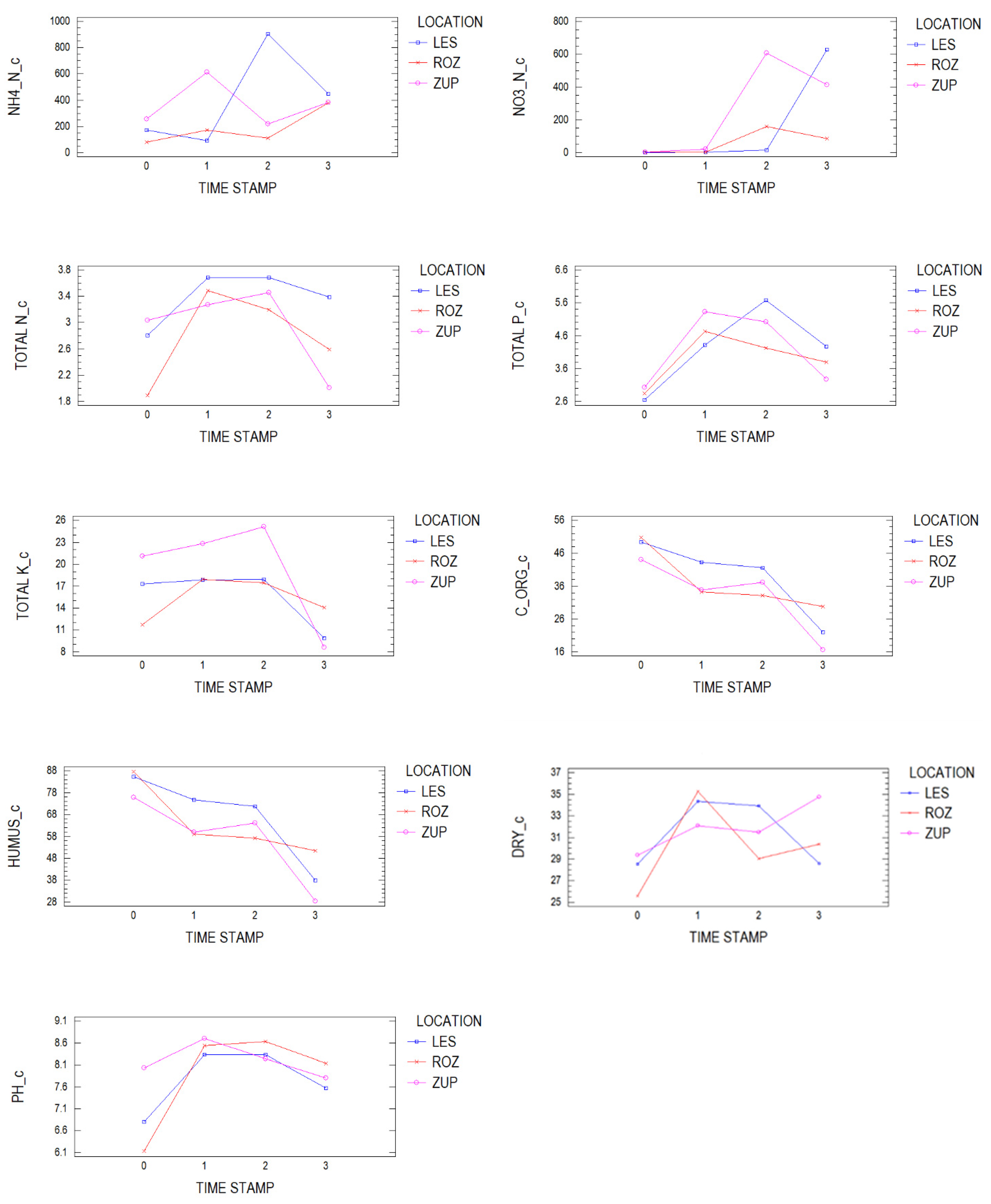
| Pile (Procedure) | Particle Size (cm) | Cover | Turning | Additive, Mixed at Pile Conduction |
|---|---|---|---|---|
| ZUP | 2–10 | / | 7-times | / |
| LES | 2–5 | / | 11-times | Biochar (11 kg/t) |
| ROZ | 1–5 | Black foil after 1 month | 2-times before covering | Effective microorganisms (2 L/t) |
| Date | LES | ROZ | ZUP | ||||||
|---|---|---|---|---|---|---|---|---|---|
| Date of Leachate Sampling | Date of Biomass Sampling | Date of Pile Turning | Date of Leachate Sampling | Date of Biomass Sampling | Date of Pile Turning | Date of Leachate Sampling | Date of Biomass Sampling | Date of Pile Turning | |
| 24 August 2020 | X | ||||||||
| 29 August 2020 | X | ||||||||
| 7 September 2020 | X | ||||||||
| 9 September 2020 | X | ||||||||
| 14 September 2020 | X | ||||||||
| 16 September 2020 | X | ||||||||
| 18 September 2020 | X | X | |||||||
| 24 September 2020 | X | X | X | X | X | X | |||
| 1 October 2020 | X | X | X | ||||||
| 5 October 2020 | X | X | X | ||||||
| 8 October 2020 | X | X | X | X | X | ||||
| 13 October 2020 | X | X | X | ||||||
| 20 October 2020 | X | X | |||||||
| 22 October 2020 | X | X | X | ||||||
| 28 October 2020 | X | X | X | ||||||
| 4 November 2020 | X | X | |||||||
| 12 November 2020 | X | X | X | ||||||
| 13 November 2020 | X | X | X | X | X | ||||
| 19 November 2020 | X | X | X | ||||||
| 25 November 2020 | X | ||||||||
| 14 January 2021 | X | X | X | ||||||
| 2 March 2021 | X | X | X | X | |||||
| 1 April 2021 | X | X | X | X | |||||
| 30 April 2021 | X | X | |||||||
| Parameter: Factor | Count | LS Mean | LS Sigma | Homogeneous Groups ** |
|---|---|---|---|---|
| NH4: Procedure | ||||
| ROZ | 5 | 363.056 | 1871.64 | a |
| ZUP | 9 | 3184.38 | 1225.27 | b |
| LES | 9 | 4807.64 | 1225.27 | b |
| NH4: Time stamp | ||||
| 1 | 9 | 1801.02 | 1225.27 | a |
| 3 | 7 | 3190.07 | 1581.82 | a |
| 2 | 7 | 3363.99 | 1581.82 | a |
| NO3: Procedure | ||||
| ROZ | 5 | 2648.71 | 16,247.4 | a |
| LES | 9 | 14,461.7 | 10,636.5 | a |
| ZUP | 9 | 39,610.7 | 10,636.5 | a |
| NO3: Time stamp | ||||
| 1 | 9 | 7.41111 | 10,636.5 | a |
| 2 | 7 | 152.478 | 13,731.6 | a |
| 3 | 7 | 56,561.2 | 13,731.6 | b |
| Total N: Procedure | ||||
| ROZ | 5 | 797.778 | 3756.96 | a |
| LES | 9 | 9503.14 | 2459.51 | b |
| ZUP | 9 | 10,970.6 | 2459.51 | b |
| Total N: Time stamp | ||||
| 1 | 9 | 2894.48 | 2459.51 | a |
| 2 | 7 | 5663.63 | 3175.21 | a,b |
| 3 | 7 | 12,713.4 | 3175.21 | b |
| Total P: Procedure | ||||
| ROZ | 5 | 5.74111 | 4.44921 | a |
| ZUP | 9 | 8.39 | 2.91269 | a |
| LES | 9 | 18.4811 | 2.91269 | b |
| Total P: Time stamp | ||||
| 1 | 9 | 13.71 | 2.91269 | b |
| 2 | 7 | 15.6322 | 3.76027 | b |
| 3 | 7 | 3.27 | 3.76027 | a |
| pH: Procedure | ||||
| ROZ | 5 | 8.33333 | 0.135628 | b |
| ZUP | 9 | 8.57778 | 0.08879 | b |
| LES | 9 | 7.98889 | 0.08879 | a |
| pH: Time stamp | ||||
| 1 | 9 | 8.38889 | 0.08879 | b |
| 2 | 7 | 8.56667 | 0.114627 | b |
| 3 | 7 | 7.94444 | 0.114627 | a |
| NH4-N (mg/kg) | NO3-N (mg/kg) | Total N (%) | Total P (g/kg) | Total K (g/kg) | C ORG (%) | Humus (%) | Dry Matter (%) | pH | |
|---|---|---|---|---|---|---|---|---|---|
| PROCEDURE | Mean | ||||||||
| ROZ | 186.8 a, ** | 61.3 a | 2.8 a | 3.9 a | 15.3 a | 37.0 b | 63.8 b | 30.1 a | 7.9 a |
| ZUP | 368.0 b | 260.7 c | 2.9 a | 4.2 a | 19.4 b | 33.1 a | 57.1 a | 31.9 a | 8.2 b |
| LES | 403.5 b | 161.3 b | 3.4 b | 4.2 a | 15.8 a | 39.1 b | 67.4 b | 31.3 a | 7.8 a |
| TIME STAMP | |||||||||
| 0 | 169.6 a | 0.8 a | 2.6 a | 2.8 a | 16.7 b | 48.1 c | 82.9 c | 27.8 a | 7.0 a |
| 1 | 291.7 b | 7.8 a | 3.5 b | 4.8 c | 19.6 c | 37.5 b | 64.6 b | 33.9 b | 8.5 c |
| 2 | 412.6 c | 259.8 b | 3.4 b | 5.0 c | 20.2 c | 37.3 b | 64.3 b | 31.5 a,b | 8.4 c |
| 3 | 403.8 c | 375.9 c | 2.7 a | 3.8 b | 10.8 a | 22.8 a | 39.2 a | 31.2 a,b | 7.8 b |
| Date | Rain Amount from the Previous Date (mm) | Average Leachate Volume (mL/m2) | NH4 (mg/m2) | NO3 (mg/m2) | Total N (mg/m2) | Total P (mg/m2) |
|---|---|---|---|---|---|---|
| 18 September 2020 | 0 | 653 | 16.4 | 0.5 | 87.3 | 0.8 |
| 24 September 2020 | 1.4 | 1350 | 195.2 | 0.9 | 345.2 | 1.7 |
| 5 October 2020 | 91 | 15,003 | 1642.7 | 13.2 | 3936.3 | 19.6 |
| 13 October 2020 | 95.8 | 25,667 | 2806.4 | 63.1 | 7424.0 | 31.8 |
| 20 October 2020 | 28.4 | 3767 | 567.2 | 17.4 | 1151.1 | 3.1 |
| 28 October 2020 | 9.4 | 1420 | 340.1 | 19.5 | 518.8 | 1.2 |
| 4 November 2020 | 0.4 | 3333 | 1059.3 | 16.4 | 1445.2 | 1.2 |
| 12 November 2020 | 0 | 1147 | 278.5 | 15.1 | 448.3 | 0.9 |
| 19 November 2020 | 34.8 | 2500 | 800.8 | 49.7 | 1146.5 | 1.7 |
| 14 January 2021 | 170.6 | 18,667 | 5238.3 | 17,411.8 | 10,157.3 | 0.4 |
| Correlation | RAIN | VOLUME | NH4 | NO3 | Total N | Total P |
|---|---|---|---|---|---|---|
| RAIN_AMOUNT | 0.8605 | 0.8668 | 0.6333 | 0.9189 | 0.3744 | |
| 0.0003 | 0.0003 | 0.0271 | 0 | 0.2305 | ||
| VOLUME | 0.778 | 0.3605 | 0.7926 | 0.751 | ||
| 0.0029 | 0.2496 | 0.0021 | 0.0049 | |||
| NH4 | 0.3871 | 0.7926 | 0.3504 | |||
| 0.2139 | 0.0021 | 0.2642 | ||||
| NO3 | 0.4352 | 0.2902 | ||||
| 0.1573 | 0.3603 | |||||
| Total N | 0.4917 | |||||
| 0.1044 | ||||||
| Total P | ||||||
Publisher’s Note: MDPI stays neutral with regard to jurisdictional claims in published maps and institutional affiliations. |
© 2022 by the authors. Licensee MDPI, Basel, Switzerland. This article is an open access article distributed under the terms and conditions of the Creative Commons Attribution (CC BY) license (https://creativecommons.org/licenses/by/4.0/).
Share and Cite
Čeh, B.; Luskar, L.; Hladnik, A.; Trošt, Ž.; Polanšek, J.; Naglič, B. The Quantity and Composition of Leachate from Hop Plant Biomass during Composting Process. Appl. Sci. 2022, 12, 2375. https://doi.org/10.3390/app12052375
Čeh B, Luskar L, Hladnik A, Trošt Ž, Polanšek J, Naglič B. The Quantity and Composition of Leachate from Hop Plant Biomass during Composting Process. Applied Sciences. 2022; 12(5):2375. https://doi.org/10.3390/app12052375
Chicago/Turabian StyleČeh, Barbara, Lucija Luskar, Aleš Hladnik, Žan Trošt, Julija Polanšek, and Boštjan Naglič. 2022. "The Quantity and Composition of Leachate from Hop Plant Biomass during Composting Process" Applied Sciences 12, no. 5: 2375. https://doi.org/10.3390/app12052375
APA StyleČeh, B., Luskar, L., Hladnik, A., Trošt, Ž., Polanšek, J., & Naglič, B. (2022). The Quantity and Composition of Leachate from Hop Plant Biomass during Composting Process. Applied Sciences, 12(5), 2375. https://doi.org/10.3390/app12052375






